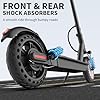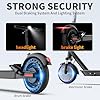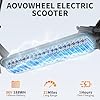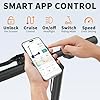Aovowheel Electric Scooter for Adults, Folding E Scooter with 350W/500W Motor 16-24 Mph Top Speed, Max 15-60 Miles Long Range, 6.5''/8.5''/10''/14'' Solid Tires Commuting Scooters, Dual Brakes, APP
43% OffFlying with a hoverboard can be tricky due to strict airline regulations—especially concerning lithium-ion batteries. If you’re planning air travel in 2025, this guide breaks down the latest policies, safety precautions, and expert-approved alternatives.
🔑 Key Takeaways
✔ Most airlines ban hoverboards due to fire risks from lithium batteries.
✔ Battery limits apply (usually ≤160Wh per passenger for checked luggage).
✔ TSA & FAA rules vary—always check your airline’s policy 72 hours before flying.
✔ Safer alternatives include FAA-approved scooters or renting at your destination.
✔ Packing tips reduce risks: discharge batteries, use fireproof bags, and declare them.
✈️ Hoverboard Airline Policies in 2025
1. Why Are Hoverboards Restricted?
Hoverboards use lithium-ion batteries, which can overheat and catch fire if damaged or defective. After multiple incidents, the FAA banned loose batteries in checked luggage, and most airlines extended this to hoverboards.
Real-World Example:
In 2024, a Delta flight made an emergency landing after a passenger’s hoverboard battery smoked in the overhead bin.
2. Airline-Specific Rules (2025)
| Airline | Allowed? | Battery Limit | Notes |
|---|---|---|---|
| Delta | ❌ No | — | Banned since 2016 |
| United | ❌ No | — | Includes “smart” self-balancing boards |
| American | ✔ Yes (≤160Wh) | 160Wh | Must be carry-on, airline approval required |
| Southwest | ❌ No | — | No exceptions |
Pro Tip:
Airlines like American may allow hoverboards if the battery is ≤160Wh and packed in carry-on—but approval is case-by-case.
🔋 Battery Safety & Packing Tips

1. FAA Lithium Battery Rules
- ≤100Wh: Allowed in carry-on (no approval needed).
- 100–160Wh: Airline approval required (max 2 spare batteries).
- >160Wh: Banned (common for high-power hoverboards).
How to Check Your Battery:
Look for the Wh rating on the label (Volts × Amp-hours = Watt-hours). Most hoverboards use 200–400Wh batteries, exceeding limits.
2. Packing for Safety
- Discharge to 30% before flying.
- Use a fireproof LiPo bag (e.g., EVASafe).
- Carry manufacturer’s certification to prove compliance.
🚫 What If Your Airline Bans Hoverboards?
1. Rent at Your Destination

Companies like Lime and Bird rent e-scooters in major cities—no airport hassle.
2. Ship Ahead
Services like FedEx Ground accept hoverboards (declare batteries separately).
3. FAA-Approved Alternatives
- Glion Dolly (foldable, 160Wh battery).
- Segway Ninebot S (UL2272 certified).
❓ FAQ: Hoverboards on Planes
Q: Can I bring a hoverboard in checked luggage?
A: No. FAA bans lithium batteries in checked bags due to fire risks.
Q: What happens if TSA finds a hoverboard in my bag?
A: It may be confiscated, or you’ll be forced to abandon it. Always call your airline first.
Q: Are any hoverboards FAA-approved?
A: Rarely. Look for UL2272 certification and batteries ≤160Wh.
✅ Bottom Line
Most hoverboards won’t be allowed on planes in 2025 due to battery risks. Check your airline’s policy, consider renting, or ship ahead. For stress-free travel, opt for FAA-compliant scooters instead.
Need More Help? Comment below

I’m the founder of HoverboardsGuide.com, a comprehensive website dedicated to electric scooters and hoverboards. With a deep-rooted passion for electric gadgets, I’ve accumulated extensive experience in this field. I aim to assist users in selecting the best gadgets and providing reliable guidance.
I’ve tested and reviewed numerous models, gaining in-depth knowledge about their features, performance, and overall quality. Feel free to reach out to me with any queries, as I’m dedicated to addressing your concerns promptly. Join me on this exciting journey of exploring the world of electric rides and making informed decisions













